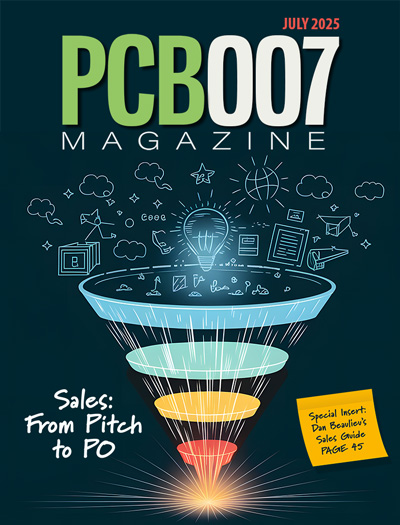-

- News
- Books
Featured Books
- pcb007 Magazine
Latest Issues
Current Issue
Inventing the Future with SEL
Two years after launching its state-of-the-art PCB facility, SEL shares lessons in vision, execution, and innovation, plus insights from industry icons and technology leaders shaping the future of PCB fabrication.

Sales: From Pitch to PO
From the first cold call to finally receiving that first purchase order, the July PCB007 Magazine breaks down some critical parts of the sales stack. To up your sales game, read on!

The Hole Truth: Via Integrity in an HDI World
From the drilled hole to registration across multiple sequential lamination cycles, to the quality of your copper plating, via reliability in an HDI world is becoming an ever-greater challenge. This month we look at “The Hole Truth,” from creating the “perfect” via to how you can assure via quality and reliability, the first time, every time.
- Articles
- Columns
- Links
- Media kit
||| MENU - pcb007 Magazine
IPC President John Mitchell on the Past, Present, and Future, Part 1
April 7, 2016 | Barry Matties, I-Connect007Estimated reading time: 18 minutes
IPC FIVE KEY MEASURES
Mitchell: We have five measures that we get reviewed with by the board. Obviously, there are business measures. We have two in that area. The primary one is, did we hit our budget? And that's in terms of the net. This year we have a budget to break even. Of every dollar that we bring in basically we're spending it to serve the industry. We had that same goal last year and we did a good job. We met that budget.
The previous two years, the board strategically invested in the industry. IPC ran a budget deficit during that time. We were making investments in various things that we thought would help the industry, and the Board approved that. They're willing to have IPC go out there and do that.
Matties: How did those investments pay off?
Mitchell: Some of them are programs like CQI (Certification Quality Initiative), which we think is paying off very, very nicely for the industry. We’ve improved the quality of the certification testing, bringing it up to a modern online testing format. We were using paper tests, and we knew there were people not abiding by the rules. The new system gives us analytics. We can sit there and say, “Patty happened to teach a class and her whole class struggled on this one module on the test.” We can reach back out to the teacher and say, “You might look at how you're teaching this because they're struggling in that portion of the test.” We could never do that before.
Matties: You get good feedback.
Mitchell: We get good feedback. Additionally, if, for example, 76% of the people on a particular question are missing it, either there's a problem with the question or we're not covering it in the materials. We can then improve the whole process in that way. We get some great analytics we've never been able to see before. That's been an investment that we feel has really panned out.
Similarly, we're investing in Validation Services, which is a little slower going because it takes a while for industry-wide acceptance. Regardless, we keep moving forward. We're looking for increased OEM buy-in to ensure the benefits are felt everywhere.
Matties: This is a tough area to get buy-in from, isn't it?
Mitchell: It is, and it’s tough because the whole goal of any program that we launch is to reduce the overall burden on the industry. If it's costing people more to do this and the overall return is down, we don’t even do the program. The idea of validation is that some people will say, “It’s just another audit and we hate the word audit,” but I used it so forgive me. That's how a lot of board shops and assembly shops may view it, but we're trying to work with the OEMs and say, “If we do this, and you're coming in four times a year for four days each, can we cut that in half?”
If they sign up for that, now suddenly they've got six OEMs coming in, and if all of them cut it in half and we only have to come in ourselves and do it, now everybody’s saving money. OEMs are going less, so it saves them money. EMS companies, in that case, have less down time because if they're doing ours and the OEMs are checking the box, they are there only half the time. Those are the ideas that we're trying to implement, but it takes some time on some of these.
Generally stated, if customer audits can be reduced and supplier downtime can be reduced while maintaining, or even improving quality, IPC owes it to the industry to strive to bring those advantages from theory to reality. That is what Validation Services is striving to do.
Matties: How do you take a program like that and put the line in and say we're going to continue or kill it? Is there a critical measure on that?
Mitchell: We're asked that by the Board. How long are you going to invest in this before you say it’s either been accepted or not? Let me use the example of the certification program. It took a decade for it to really get accepted. We're willing to take the long road on some of these things. Other programs, we're trying to find ways to accelerate because we think the benefits are there. We put a little bit more “oomph” on it, but really in this industry, if you find the OEMs will accept something, it's pretty much done.
When your customer says, “Do this because it's going to save us money and save you money, but you have to take the longer view.” That's a tough thing, so we try to present longer view solutions because saving money this year is nice. Saving this money over the next three decades…now, that's really nice.
Matties: One of the key measures is budget. What are the other four?
Mitchell: One we call standards influence. It’s the propagation and utilization of standards, and that includes standards as documents, as well as standards in certification programs. We even include events like this one where we're doing standards participation. That’s a very complex thing to measure, so we actually just measure that in dollars that the industry spends on it. That’s where our revenue ties into that.
Another one is membership growth. We measure that by how many new members we have.
Matties: Interestingly, I recently conducted an interview with Phil Carmichael [IPC president of Greater China] and was learning about the increase in members in Asia and China…which is significant growth in a very short time.
Mitchell: I think he's close to 800 members now in all of Asia. Just in China, he's doubled the membership in the last couple of years.
Matties: What about Europe and the Americas?
Mitchell: Overall, the trend is up. Globally we are continuing to grow, which is great. We’re growing faster outside of the U.S. than inside of the U.S. because it’s newer. We've got a good base here in the U.S.
Matties: But you're going to plateau at some point?
Mitchell: I think at some point, yes, but I think that point is something like 50 years down the road.
Matties: We take the long view here at IPC (laughs).
Mitchell: I'm not worried about it (laughing). There are a lot of opportunities for us to show the value of IPC membership and IPC standards, etc., to lots of organizations, and to show them how by becoming members they can enhance their financial success and operational excellence. That's the mission.
Matties: I can't see that growth going on here in America.
Mitchell: No, it’ll shift though and change. We’ve had a consolidation of PCBs, right, so you now have very few companies compared to 20 years ago. We might see that happen in EMS in the U.S. You never know.
Goldman: But they aren’t all members, by a long shot.
Mitchell: No, right now only 50% of the PCB companies in the U.S. are members, about 150 out of the 300 or so PCB companies are IPC members.
Goldman: How can you reach those other 50%?
Page 3 of 4
Testimonial
"In a year when every marketing dollar mattered, I chose to keep I-Connect007 in our 2025 plan. Their commitment to high-quality, insightful content aligns with Koh Young’s values and helps readers navigate a changing industry. "
Brent Fischthal - Koh YoungSuggested Items
Honeywell-Led Consortium Receives UK Government Funding to Revolutionize Aerospace Manufacturing
09/02/2025 | HoneywellA consortium led by Honeywell has received UK Government funding for a project that aims to revolutionize how critical aerospace technologies are manufactured in the UK through the use of AI and additive manufacturing.
Coherent Announces Agreement to Sell Aerospace and Defense Business to Advent for $400 Million
08/15/2025 | AdventCoherent Corp., a global leader in photonics, today announced that it has entered into a definitive agreement to sell its Aerospace and Defense business to Advent, a leading global private equity investor, for $400 million. Proceeds will be used to reduce debt, which will be immediately accretive to Coherent’s EPS.
KYZEN Partners with LPW to Elevate High Purity Cleaning with Cutting-Edge Cyclic Nucleation Technology in North America
08/13/2025 | KYZEN'KYZEN, a global leader in advanced cleaning solutions, has reached a major milestone in high-purity cleaning with the addition of a state-of-the-art Vacuum Cyclic Nucleation System at its North American Application Lab.
Jeh Aerospace Raises $11M to Boost Aircraft Supply Chain
08/12/2025 | I-Connect007 Editorial TeamJeh Aerospace, the high-precision aerospace and defense manufacturing startup founded by Vishal Sanghavi and Venkatesh Mudragalla, has raised $11 million in a Series A round led by Elevation Capital, with support from General Catalyst, to scale its commercial aircraft supply chain manufacturing in India, according to OEM.
New Frontier Aerospace and Air Force Institute of Technology Sign CRADA to Advance Hypersonic VTOL Aircraft
08/05/2025 | PR NewswireNew Frontier Aerospace (NFA) is excited to announce a Collaborative Research and Development Agreement (CRADA) with the Air Force Institute of Technology (AFIT) aimed at advancing an innovative rocket-powered hypersonic Vertical Takeoff and Landing (VTOL) aircraft.


